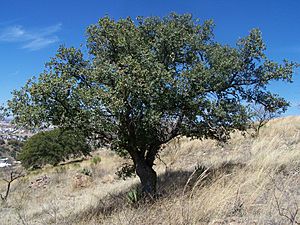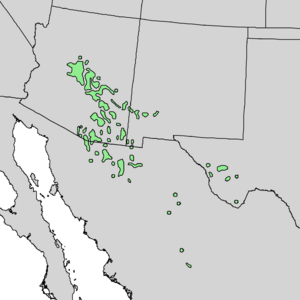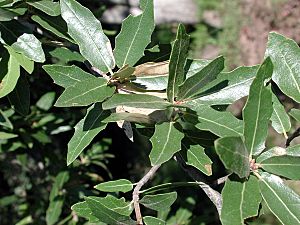Emory oak facts for kids
Quick facts for kids Emory oak |
|
|---|---|
 |
|
| Conservation status | |
| Scientific classification | |
| Genus: |
Quercus
|
| Species: |
emoryi
|
 |
|
| Natural range of Quercus emoryi | |
| Synonyms | |
|
|
The Emory oak, also known by its scientific name Quercus emoryi, is a type of oak tree. You can find it growing in dry, hilly areas. It is common in the southwestern United States, like Arizona and New Mexico. It also grows in northern Mexico.
This tree is an evergreen tree. This means it keeps its leaves all winter long. New leaves grow in the spring. The Emory oak is usually a large shrub or a small tree. It can grow from about 16 to 56 feet (5 to 17 meters) tall.
The leaves are about 1 to 2.5 inches (3 to 6 cm) long. They can be smooth or have wavy edges. The leaves feel leathery and are dark green on top. They are lighter green underneath.
The acorns of the Emory oak are special. They are about 0.5 to 1 inch (1.5 to 2 cm) long. They turn blackish-brown when they are ready. It takes 6 to 8 months for them to grow after the tree is pollinated. The inside of the acorn is sweet. It is an important food for both people and animals.
The seeds of this tree have different names. In the Ndee language, they are called chich’il. The O’odham people call them wi-yo:thi or toa. In Spanish, they are known as bellotas. In English, we call them acorns. The tree's English and Latin names honor Lieutenant William Hemsley Emory. He was a United States Army surveyor in the 1840s. He explored the area that is now west Texas.
Contents
Emory Oak: Food and Habitat
The sweet acorns of the Emory oak are a key food source. Many animals enjoy eating them. This includes livestock, deer, and squirrels. Even birds like quail and wild turkeys eat them. Deer and livestock also munch on the tree's leaves.
Traditional Uses of Acorns
Native American groups, such as the Apaches, have used Emory acorns for a long time. They use them in their traditional meals and special ceremonies. Today, these acorns are still part of their cooking. They can be ground into a meal and used in many recipes.
Protecting Emory Oak Forests
The health of Emory oak trees and their homes has faced challenges. In Arizona, a place called Oak Flat has a very old Emory oak forest. This forest is important to the Apache people. It is also a special natural area.
A mining company wants to dig for copper there. This plan would mean cutting down many of these old trees. The area at Oak Flat was protected in the 1950s. President Eisenhower said it should never be mined. However, the mining company has worked to get permission to mine this federal land. The unique oak grove at Oak Flat cannot be replaced once it is gone.
Working to Restore Oak Habitats
For many years, Apache elders worried about the oak groves. They saw fewer acorns and less healthy trees. This was due to changes like cattle walking on young trees. Also, stopping wildfires made the forests too thick.
The Emory Oak Collaborative Tribal Restoration Initiative is a program working to help. It aims to restore and protect Emory oak stands. This helps make sure these trees will be around for a long time. Things like losing habitat, too much grazing by animals, and climate change have hurt the Emory oak population. This program uses traditional knowledge from tribes to guide its efforts.
See also
 In Spanish: Encina Emory para niños
In Spanish: Encina Emory para niños



